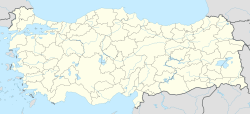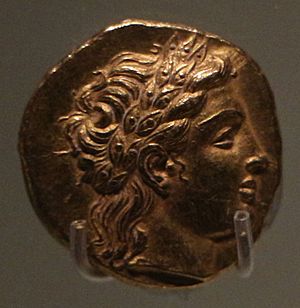Cius facts for kids
| Location | Turkey |
|---|---|
| Region | Bursa Province |
| Coordinates | 40°25′57″N 29°09′23″E / 40.432468°N 29.156389°E |
Cius ( Greek: Kίος or Κῖος Kios) was an ancient Greek city. It was located on the coast of the Propontis, which is now called the Sea of Marmara. This area is in modern-day northwestern Turkey.
Cius had a very long history. Famous ancient writers like Herodotus and Xenophon wrote about it. Later, the city was renamed Prusias on the Sea after King Prusias I of Bithynia.
Contents
Where was Cius located?
Cius was built in a great spot at the top of a gulf. This gulf was known as the gulf of Cius. The city was at the foot of a mountain called Mount Arganthonius.
Myths about Cius
Ancient stories tell us that a hero named Hylas visited this area. He was a friend of Heracles, a very strong hero. The myth says that nymphs, who were nature spirits, took Hylas away when he went to get water near Cius. Another story says that Cius, another friend of Heracles, founded the city. He gave the city his own name. There were even rivers nearby named Hylas and Cius, which might be linked to these old myths.
A busy trading port
Because of its location, Cius became a very important port city. It was a gateway for goods coming from inland areas. People called it a great trading center for Phrygia, a region not far away.
What happened in Cius's history?
Cius had an exciting and sometimes difficult history. The Persians captured the city in 499 BCE. Later, Cius joined a group of cities called the Aetolian League.
Destruction and rebirth
In the Second Macedonian War (200-197 BCE), Philip V of Macedon destroyed Cius. But then, King Prusias I of Bithynia helped rebuild it. He renamed the city Prusias. To tell it apart from other cities with the same name, people often called it "Prusias on the sea." Even after being renamed, the old name Cius was still sometimes used.
A stop on the Silk Road
Cius was an important part of the ancient Silk Road. This was a famous network of trade routes connecting the East and West. Because of its role in trade, Cius became a very wealthy city. It was also a member of the Delian League, a group of Greek city-states led by Athens.
Ancient coins from Cius
We know about Cius from the coins found there. Some coins from the Roman imperial period have the name "Kianon" on them, which means "of the people of Cius." Other coins from the time it was called Prusias have "Prousieon ton pros thalassan," meaning "of the people of Prusias on the sea."
Cius as an early Christian center
Cius was also important in early Christian history. It had its own bishop, a leader of the church. Bishops from Cius attended important church meetings, like the First Council of Nicaea in 325 CE. Today, Cius is no longer an active bishopric. Instead, it is a "titular see," which means it's a historical title used by the Catholic Church.
What happened to Cius later?
After a population exchange in 1923, many Greek people from Cius moved to Greece. They founded new towns there, like Nea Kios and Paralia. Today, there are only a few remains of the ancient city and its harbor. A modern town called Gemlik is now located nearby in Turkey.
See also
 In Spanish: Cío para niños
In Spanish: Cío para niños



